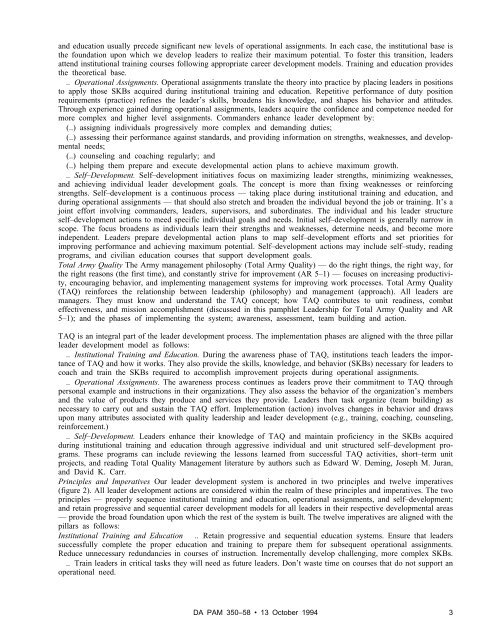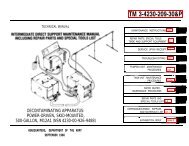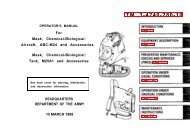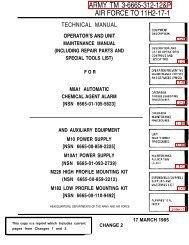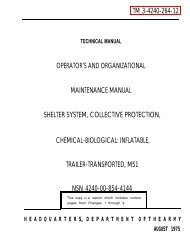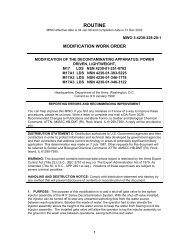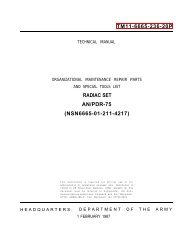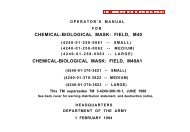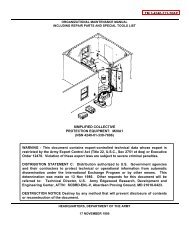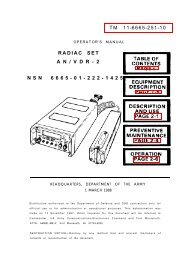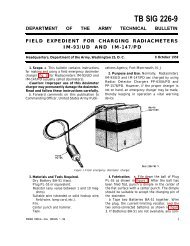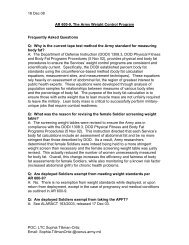LEADER DEVELOPMENT FOR AMERICA'S ARMY
LEADER DEVELOPMENT FOR AMERICA'S ARMY
LEADER DEVELOPMENT FOR AMERICA'S ARMY
Create successful ePaper yourself
Turn your PDF publications into a flip-book with our unique Google optimized e-Paper software.
and education usually precede significant new levels of operational assignments. In each case, the institutional base is<br />
the foundation upon which we develop leaders to realize their maximum potential. To foster this transition, leaders<br />
attend institutional training courses following appropriate career development models. Training and education provides<br />
the theoretical base.<br />
.. Operational Assignments. Operational assignments translate the theory into practice by placing leaders in positions<br />
to apply those SKBs acquired during institutional training and education. Repetitive performance of duty position<br />
requirements (practice) refines the leader’s skills, broadens his knowledge, and shapes his behavior and attitudes.<br />
Through experience gained during operational assignments, leaders acquire the confidence and competence needed for<br />
more complex and higher level assignments. Commanders enhance leader development by:<br />
(..) assigning individuals progressively more complex and demanding duties;<br />
(..) assessing their performance against standards, and providing information on strengths, weaknesses, and developmental<br />
needs;<br />
(..) counseling and coaching regularly; and<br />
(..) helping them prepare and execute developmental action plans to achieve maximum growth.<br />
.. Self–Development. Self–development initiatives focus on maximizing leader strengths, minimizing weaknesses,<br />
and achieving individual leader development goals. The concept is more than fixing weaknesses or reinforcing<br />
strengths. Self–development is a continuous process — taking place during institutional training and education, and<br />
during operational assignments — that should also stretch and broaden the individual beyond the job or training. It’s a<br />
joint effort involving commanders, leaders, supervisors, and subordinates. The individual and his leader structure<br />
self–development actions to meed specific individual goals and needs. Initial self–development is generally narrow in<br />
scope. The focus broadens as individuals learn their strengths and weaknesses, determine needs, and become more<br />
independent. Leaders prepare developmental action plans to map self–development efforts and set priorities for<br />
improving performance and achieving maximum potential. Self–development actions may include self–study, reading<br />
programs, and civilian education courses that support development goals.<br />
Total Army Quality The Army management philosophy (Total Army Quality) — do the right things, the right way, for<br />
the right reasons (the first time), and constantly strive for improvement (AR 5–1) — focuses on increasing productivity,<br />
encouraging behavior, and implementing management systems for improving work processes. Total Army Quality<br />
(TAQ) reinforces the relationship between leadership (philosophy) and management (approach). All leaders are<br />
managers. They must know and understand the TAQ concept; how TAQ contributes to unit readiness, combat<br />
effectiveness, and mission accomplishment (discussed in this pamphlet Leadership for Total Army Quality and AR<br />
5–1); and the phases of implementing the system; awareness, assessment, team building and action.<br />
TAQ is an integral part of the leader development process. The implementation phases are aligned with the three pillar<br />
leader development model as follows:<br />
.. Institutional Training and Education. During the awareness phase of TAQ, institutions teach leaders the importance<br />
of TAQ and how it works. They also provide the skills, knowledge, and behavior (SKBs) necessary for leaders to<br />
coach and train the SKBs required to accomplish improvement projects during operational assignments.<br />
.. Operational Assignments. The awareness process continues as leaders prove their commitment to TAQ through<br />
personal example and instructions in their organizations. They also assess the behavior of the organization’s members<br />
and the value of products they produce and services they provide. Leaders then task organize (team building) as<br />
necessary to carry out and sustain the TAQ effort. Implementation (action) involves changes in behavior and draws<br />
upon many attributes associated with quality leadership and leader development (e.g., training, coaching, counseling,<br />
reinforcement.)<br />
.. Self–Development. Leaders enhance their knowledge of TAQ and maintain proficiency in the SKBs acquired<br />
during institutional training and education through aggressive individual and unit structured self–development programs.<br />
These programs can include reviewing the lessons learned from successful TAQ activities, short–term unit<br />
projects, and reading Total Quality Management literature by authors such as Edward W. Deming, Joseph M. Juran,<br />
and David K. Carr.<br />
Principles and Imperatives Our leader development system is anchored in two principles and twelve imperatives<br />
(figure 2). All leader development actions are considered within the realm of these principles and imperatives. The two<br />
principles — properly sequence institutional training and education, operational assignments, and self–development;<br />
and retain progressive and sequential career development models for all leaders in their respective developmental areas<br />
— provide the broad foundation upon which the rest of the system is built. The twelve imperatives are aligned with the<br />
pillars as follows:<br />
Institutional Training and Education .. Retain progressive and sequential education systems. Ensure that leaders<br />
successfully complete the proper education and training to prepare them for subsequent operational assignments.<br />
Reduce unnecessary redundancies in courses of instruction. Incrementally develop challenging, more complex SKBs.<br />
.. Train leaders in critical tasks they will need as future leaders. Don’t waste time on courses that do not support an<br />
operational need.<br />
DA PAM 350–58 • 13 October 1994<br />
3


